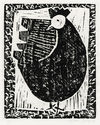
19th, 20th & 21st Century Fine Prints
707-546-7352 · fax 707-546-7924 · web: www.annexgalleries.com · email: artannex@aol.com
Milton Clark Avery Biography
Milton Clark Avery
American
1885–1965
Biography
Milton Avery, painter and printmaker, was born in Sand Bank, New York on March 7, 1885. He was the youngest of four children and the family of six moved to Hartford, Connecticut in 1898. In 1905, Avery began attending classes at the Connecticut League of Art Students in Hartford and it appears that in 1918 he attended the School of the Art Society also in Hartford. In 1920, he began spending summers in Gloucester, Massachusetts and it was there, in 1924, that he met Sally Michel.
Avery moved to New York in 1925 and married Sally. He attended evening classes at the Art Students’ League and in 1927 began to exhibit in group shows. His first New York exhibition was held in 1928 at the Opportunity Gallery and that same year he befriended Mark Rothko who introduced him to Barnett Newman and Adolph Gottlieb. In 1944, he had his first museum show at the Phillips Collection in Washington, D.C. Milton and Sally were both awarded fellowships at the MacDowell Artists’ Colony in Peterborough, New Hampshire in 1953, 1954, and 1956. In 1960, Milton received a Ford Foundation grant.
Milton Avery’s work is in numerous collections including, but not limited to, the Addison Gallery of American Art, Birmingham Museum of Art, Brooklyn Museum, Cleveland Museum of Art, Dayton Art Institute, Hirshhorn Museum, Metropolitan Museum, Museum of Fine Arts Boston, National Gallery of Art, Phillips Collection, Smithsonian Museum of American Art, and the Whitney Museum of American Art. During his lifetime, retrospective exhibitions were mounted at the Baltimore Museum of Art in 1952 and at the Whitney Museum of American Art in 1960.
Milton Avery died in New York City on January 3, 1965.
It has been very difficult to pin down dates for even the briefest biography on Milton Avery because his date of birth and other significant early dates differ from one major reference to another. Barbara Haskell confronted the same difficulty in her research on the artist for her book, "Milton Avery." The following quote is from her first paragraph of her book: "Milton Avery lived and worked as if to avoid biography. He left no significant autobiographical remnants. He wrote virtually nothing; participated in no organizations; and spoke with such reticence that scant oral testimony was recorded. He seemed to have had no will to express himself in any way other than painting."




